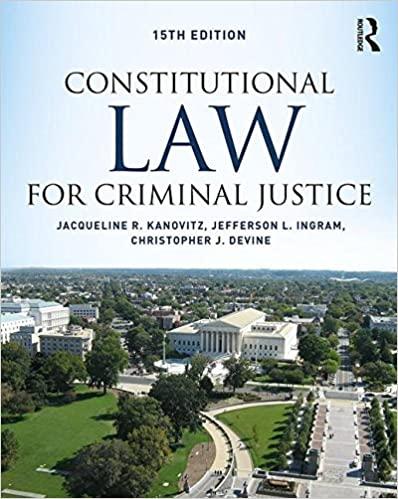Question
George Daniels v. City of Arlington, Texas 246 F.3d 500 (5th Cir. 2001) The issue is whether an employer should accommodate an employee's request to
George Daniels v. City of Arlington, Texas
246 F.3d 500 (5th Cir. 2001)
The issue is whether an employer should accommodate an employee's request to wear a religious pin.
WIENER, CIRCUIT JUDGE.
Daniels was an Arlington police officer for thirteen years. While working in a plainclothes position, he began wearing on his shirt a small, gold cross pin ("the pin") as a symbol of his evangelical Christianity. He continued to wear the pin after he was reassigned to a uniformed position, which brought him into conflict with Arlington Police Department General Order No. 205.02(C) (2)(c) ("the no-pins policy"). The General Order, as revised in November 1997, states that: "No button, badge, medal, or similar symbol or item not listed in this General Order will be worn on the uniform shirt unless approved by the Police Chief in writing on an individual basis." Daniels requested in writing that then-Police Chief David Kunkle make an exception to the policy and allow him to continue wearing the pin on his uniform. Kunkle declined, writing to Daniels that "I have not authorized any non-department related pins and I do not intend to do so." Daniels refused Kunkle's order to remove the pin from his uniform shirt and did not re- spond to the police chiefs offer of accommodations, which included: (1) wearing a cross ring or bracelet instead of the pin; (2) wearing the pin under his uniform shirt or collar; or (3) transfer ring to a non-uniformed position, where he could continue to wear the pin on his shirt. Daniels declined these alternatives and ultimately was fired for insubordination. Daniels sued, claiming that the no-pins policy is unconstitutional on its face, and that he had been the victim of intentional religious discrimination. The district court rejected Daniels's claims. Daniels asserts that Arlington Police Department General Order No. 205.02(C)(2)(c), one of many provisions regulating uniform standards for Arlington police, is an invalid prior res straint of speech protected by the First Amendment. He contends that the order is overbroad. impermissibly giving the police chief unfettered discretion to determine what expression may be displayed on an officer's uniform. This argument is unavailing. As the district court correctly noted, "a police officer's unie form is not a forum for fostering public discourse or expressing one's personal beliefs." The Supreme Court has upheld appropriate restrictions on the First Amendment rights of government employees, specifically including both military and police uniform standards. We have used two tests to determine whether speech relates to a "legitimate public come cern." Daniels fails both. The first, the citizen-employee test, turns on whether a public employee ters only of personal interest." The second evaluates the content, form, and context of a givenauthority symbolized by the police uniform, running the risk that the city may appear to endorse Daniels's religious message. The final factor, context, perhaps weighs most heavily against Daniels. Although the First Amendment protects an individual's right, for example, to shout, "Fire!" while riding a surfboard on the Pacific swells, it offers no such protection to the same speech uttered in a crowded theater. Visibly wearing a cross pin-religious speech that receives great protection in civilian life-takes on an entirely different cast when viewed in the context of a police uniform. Because Daniels's communication of his personal religious views through the pin is not speech addressing a "legitimate public concern," the departmental policy does not offend the First Amendment. As recognized in FLRA ("Federal Labor Relations Authority"), the city through its police chief has the right to promote a disciplined, identifiable, and impartial police force by maintaining its police uniform as a symbol of neutral government authority, free from expressions of personal bent or bias. The city's interest in conveying neutral authority through that uniform far outweighs an officer's interest in wearing any non-department-related symbol on it. Daniels's facial challenge to the no-pins policy fails. Having reviewed de novo the legal claims Daniels asserts on appeal, we affirm the district court's decision to dismiss his case with prejudice on summary judgment. The no-pins policy serves a legitimate governmental purpose in the context of uniformed law enforcement personnel, and Daniels undoubtedly has myriad alternative ways to manifest this tenet of his religion.
Conclusion
A police department does not violate the First Amendment when it bars officers from adorning their uniforms with individually chosen adornments, even when those decorations include symbols with religious significance. Therefore, the decision of the district court is AFFIRMED for the City of Arlington.
Case Commentary
The 5th Circuit Court held that in setting a dress code, an employer may prohibit visible religious pins.
Case Questions
1. Do you agree with the court's decision? Explain.
2. How can the freedoms of religion and speech be balanced against an employer's dress code? Explain
3. Why do some people insist on visibly wearing religious symbols paraphernalia, and why do some people find this practice intolerable? Explain
Step by Step Solution
There are 3 Steps involved in it
Step: 1

Get Instant Access to Expert-Tailored Solutions
See step-by-step solutions with expert insights and AI powered tools for academic success
Step: 2

Step: 3

Ace Your Homework with AI
Get the answers you need in no time with our AI-driven, step-by-step assistance
Get Started


